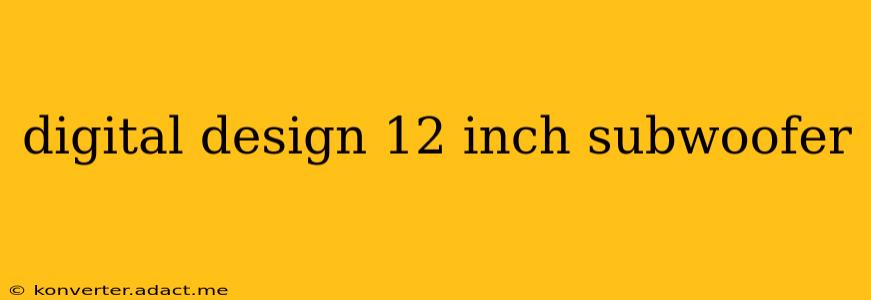Designing a high-performance 12-inch subwoofer requires a deep understanding of digital signal processing (DSP), acoustic principles, and electro-mechanical interactions. This isn't just about choosing the right components; it's about meticulously crafting a system that delivers impactful, clean bass with minimal distortion. This article delves into the key aspects of digital design for such a subwoofer, addressing common questions and offering insights for both enthusiasts and professionals.
What are the Key Considerations in Designing a 12-Inch Subwoofer?
Designing a 12-inch subwoofer involves several critical considerations that directly impact its sound quality and overall performance. These include:
-
Driver Selection: The choice of the 12-inch woofer is paramount. Factors to consider include its sensitivity, xmax (maximum excursion), voice coil parameters (resistance, inductance), and its frequency response. A high-quality driver with a robust motor structure is crucial for handling high power and delivering accurate, low-frequency reproduction.
-
Enclosure Design: The enclosure type significantly influences the subwoofer's performance. Popular options include sealed, ported (bass reflex), bandpass, and horn designs. Each has its advantages and disadvantages regarding efficiency, frequency response, and overall output. Careful modeling using software like WinISD is essential to optimize the enclosure for the chosen driver.
-
Amplifier Selection: The amplifier must be capable of providing sufficient power to drive the subwoofer without clipping or distortion. The amplifier's characteristics, such as damping factor and output impedance, interact with the subwoofer's driver impedance, affecting overall performance. Class D amplifiers are often preferred for their efficiency and power output.
-
Digital Signal Processing (DSP): DSP is crucial for fine-tuning the subwoofer's performance. Equalization (EQ) allows for correcting frequency response anomalies, while crossover filters ensure seamless integration with other speakers in a larger system. Room correction can also be implemented to mitigate the effects of room acoustics.
What Software is Used for Subwoofer Design?
Several software packages are invaluable for designing and simulating subwoofer enclosures and performance. Popular choices include:
-
WinISD: A free and widely used software for simulating bass reflex, sealed, and bandpass enclosures. It allows users to input driver parameters and enclosure dimensions to predict the subwoofer's frequency response and other performance characteristics.
-
BassBox Pro: A commercial software program offering more advanced features than WinISD, including more complex enclosure designs and detailed analysis tools.
-
Speaker Workshop: Another commercial option known for its user-friendly interface and comprehensive features.
How Does Digital Signal Processing (DSP) Improve Subwoofer Performance?
DSP significantly enhances subwoofer performance through several key functions:
-
Equalization (EQ): DSP allows for precise adjustments to the subwoofer's frequency response, compensating for irregularities in the driver's response or the effects of the enclosure. This leads to smoother, more accurate bass reproduction.
-
Crossover Filtering: DSP enables the creation of high-pass and low-pass filters, ensuring that the subwoofer only receives the frequencies it's designed to reproduce, preventing unwanted signals and improving overall system integration.
-
Room Correction: Advanced DSP algorithms can analyze the room's acoustics and apply corrections to compensate for standing waves and other acoustic anomalies, resulting in a more balanced and accurate bass response throughout the listening area.
What are the Different Types of 12-Inch Subwoofer Enclosures?
Different enclosure types offer unique advantages and disadvantages:
-
Sealed: Simple design, accurate and controlled bass response, typically less efficient than ported designs.
-
Ported (Bass Reflex): Higher efficiency than sealed enclosures, capable of producing more output at lower frequencies, but can be more prone to port noise and may have a less controlled response.
-
Bandpass: High efficiency and output, but often more complex to design and can have a narrow frequency response.
-
Horn: Extremely high efficiency and output, but generally large and complex to design and build.
What is the Best Amplifier for a 12-Inch Subwoofer?
The "best" amplifier depends heavily on the subwoofer's specific requirements and the overall system design. Consider these factors:
-
Power Output: Ensure the amplifier can provide sufficient power to drive the subwoofer without clipping.
-
Damping Factor: A higher damping factor generally provides better control over the subwoofer's driver, resulting in tighter and more accurate bass.
-
Output Impedance: The amplifier's output impedance should be matched to the subwoofer's impedance to optimize power transfer and prevent issues.
-
Features: Look for features like adjustable crossover frequencies, equalization, and protection circuits.
By carefully considering these aspects of digital design, you can create a high-performance 12-inch subwoofer system that delivers exceptional sound quality and impactful low-frequency reproduction. Remember that proper simulation and testing are crucial for achieving optimal results.
